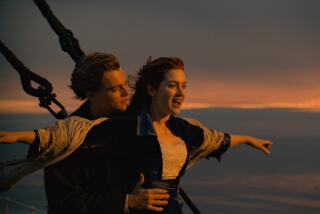ABSORBING : Titanic Legend and Truths Are Raised Again in Fullerton
- Share via
“. . . Slowly she reared up on end until at last she was absolutely perpendicular. Then, quite quietly but quicker and quicker, she seemed to slide away . . . and disappear.”
That oral eyewitness account of the sinking of the Titanic, delivered in a crisp British accent by the ship’s surviving second officer, a Mr. Lightoller, is only one of the details that makes “Titanic”--at the Fullerton Museum Center through June 23--such an absorbing exhibit.
Viewers listening to accounts of the final moments of the mammoth ocean liner are in a darkened room, looking at a model of the foundering ship with its rows of bright lights casting an eerie green tinge on the water. So when a voice on the tape recalls “that greenish water creeping up, step after step (with) a sort of ghastly transparency,” the imagination is off and running.
The wreck of the Titanic in April, 1912, was the worst shipping disaster ever to occur in peacetime. Making its maiden voyage from Southhampton, England, to New York, the stately liner was zipping along in calm weather when it struck an iceberg, which tore a 300-foot gash in the starboard side.
Two hours and forty minutes later, it was under water. Of the 2,201 people on board, there were only 712 survivors.
Touted for its “comfort, elegance and security,” the world’s largest ship--as tall as an 11-story building, as long as three football fields--was said to be so well appointed that you almost could mistake it for a mansion on shore. It was outfitted with a gym, Turkish baths, a pool, a squash court, a “palm court veranda,” a lounge modeled after a room in Versailles and--oh, technology!--”silently revolving doors.”
All this was to tantalize the American millionaires expected to sign up for the first-class cabins. Safety was almost an afterthought. And nobody really said the Titanic was unsinkable.
Rather, the 16 watertight compartments in the hull were designed so that the ship would remain afloat if any two were flooded. As one advertisement put it, “By simply moving an electric switch,” the captain could “instantly close the watertight doors throughout, practically making the vessel unsinkable.”
What the captain couldn’t do, however, was deal with flooding in six of the compartments, which brought the vessel to its knees.
All sorts of lore immediately began to grow up around the tragedy, lore amply documented--and, when necessary, tempered by truth--in the exhibit, organized by the Ulster Folk and Transport Museum in Ireland.
It is true, for example, that there were only 20 lifeboats on board, which could accommodate only 1,178 people. Management believed storing more boats would have interfered with the promenading space and reduced the sense of passenger security. But regulations of the day--woefully out of date for a ship of the Titanic’s size--required only 16 lifeboats.
It’s also true that the immigrant third-class passengers, who had no direct access to the lifeboats, suffered disproportionate loss of life. A model with clusters of little dolls representing both the quick and the dead makes that clear. While 115 men and 5 women from first class died, 399 men, 81 women and 53 children from third class perished.
The exhibit suggests a number of other--perhaps debatable--reasons why the poorer people died in greater numbers: Their (superstitious?) reluctance to leave the ship, their unwillingness to part with their luggage (which, of course, represented all they had in the world) and their inability to understand English.
To help fill in the outlines of the disaster, the exhibit contains dioramas of various types of cabins and public rooms on the ship, samples of ship’s correspondence (one confident passenger to his wife: “So far, up until now, you cannot feel (the ship) move”) and facsimiles of dazzling advertisements and devastating news accounts.
There are also examples of post-crisis hucksterism (disaster mementoes) and moralizing, and video images (rather boring) of anonymous-looking objects a modern research team found at the underwater site of the ship. A 60-minute National Geographic documentary video is stuffed with awful cliches (“poised on the brink of destiny”) but useful in recounting just how Robert Ballard followed his “dream” and assembled a team to find the sunken ship.
A cheerful recorded melody from the Titanic period is piped into the exhibit. Maybe this is the dance tune the ship’s band reportedly had been playing before it supposedly switched to “Nearer My God to Thee”--which sent sheet music sales of the hymn soaring in the wake of the tragedy. Actually, other accounts not acknowledged by the exhibit say the band wasn’t playing at all because British bands didn’t play on Sundays. . . .
As an absurd footnote to the whole captivating story, the exhibit contains laughably earnest documentation of the Fullerton Museum Center’s efforts in tracking down any possible grains of truth in a recent tabloid account. It claimed a woman survivor of the Titanic--who would have been about 120 years old--was recently found clinging to an iceberg.
The moral is, presumably, that people’s lust to know more about the great misfortunes of other people never dies.
What: “Titanic.”
When: 11 a.m. to 4 p.m. Tuesday, Wednesday, Saturday and Sunday; 11 a.m. to 9 p.m. Thursday and Friday. Through June 23.
Where: Fullerton Museum Center, 301 N. Pomona Ave., Fullerton.
Whereabouts: Take the Orange Freeway to Chapman Avenue and go west to Pomona Avenue, in downtown Fullerton, east of Harbor Boulevard.
Wherewithal: Admission is $2 for adults, $1 for students and senior citizens and free for children under 12. Everyone gets in free on Thursdays from 6 to 9 p.m.
Where to call: (714) 738-6545.
More to Read
Sign up for The Wild
We’ll help you find the best places to hike, bike and run, as well as the perfect silent spots for meditation and yoga.
You may occasionally receive promotional content from the Los Angeles Times.






